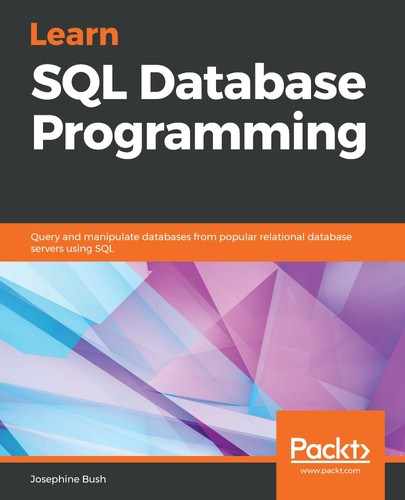Datetime built-in functions allow you to manipulate datetime values. There are many different datetime functions. The commonly used datetime built-in functions are listed next. Note that each of them can be used with a date value, a column with date values, or an expression that contains date values.
To get the current date or time, use the following:
- CURRENT_DATE: This returns the current date.
- CURRENT_DATE(): This returns the date in YYYY-MM-DD format—that is, 2020-01-11.
- CURRENT_TIME—This returns the current time.
- CURRENT_TIME(): This returns the time in HH:MM:SS format—that is, 21:09:27.
- CURRENT_TIMESTAMP: This returns the current date and time.
- CURRENT_TIMESTAMP(): This returns the datetime in YYYY-MM-DD HH:MM:SS format—that is, 2020-01-11 21:10:23.
- NOW: This returns the current date and time in the same format as CURRENT_TIMESTAMP.
- NOW(): This returns the datetime in YYYY-MM-DD HH:MM:SS format—that is, 2020-01-11 21:10:23.
To format dates and times, use the following:
- DATE_FORMAT: This formats a date into a specified format.
- DATE_FORMAT(date, format): Here, date is a valid date value and format is the format you want the date in. For example, DATE_FORMAT(NOW(), %m-%d-%y') will return 01-12-20 (depending on the date you run it). To read about all the formats you can use, see the DATE_FORMAT information in the Further reading section of this chapter.
- TIME_FORMAT: This formats a time into a specified format.
- TIME_FORMAT(time, format): Here, time is a valid time value, and format is the format you want the time in. For example, TIME_FORMAT(NOW(), '%T') will return the current time in 24-hour format, 18:52:24 (depending on the time you run it). To read about all the formats you can use, see the TIME_FORMAT information in the Further reading section of this chapter.
To add or subtract dates and times, use the following:
- ADDDATE : This adds a date interval from a date and returns that date.
- ADDDATE(date, INTERVAL value addunit): Here, date is a valid date value, INTERVAL is a keyword that stays unchanged, value is a number, and addunit is the unit of time, such as DAY. For example, ADDDATE('2020-01-01', INTERVAL 5 DAY) will return 2020-01-06 because the ADDDATE function will add 5 days to the date specified. To read about all INTERVAL you can use, see the ADDDATE information in the Further reading section of this chapter.
- ADDTIME—This adds a date/time interval from a date and returns that date.
- ADDTIME(datetime, addtime)—Here, datetime is a valid datetime value, and addtime is the amount of time to add (positive or negative). For example, ADDTIME('2020-01-01 10:10:10', '8:10:5') will return 2020-01-01 18:20:15 because the ADDTIME function will add 8 hours, 10 minutes, and 5 seconds to the date specified.
- DATE_SUB: This subtracts a date/time interval from a date and returns that date.
- DATE_SUB(date, INTERVAL value subunit)—Here, date is a valid date value, INTERVAL is a keyword that stays unchanged, value is a number, and subunit is the unit of time, such as DAY. For example, DATE_SUB('2020-01-01', INTERVAL 5 DAY) will return 2019-12-27 because the DATE_SUB function will add 5 days to the date specified. DATE_SUB INTERVAL is the same as ADDDATE INTERVAL.
- DATEDIFF: This returns the number of days between two date values.
- DATEDIFF(date1, date2)—Here, date1 and date2 are two valid datetimes. It will calculate the difference between date1 and date2. For example, DATEDIFF('2020-01-01', '2020-01-03') results in -2.
To get pieces of the date or time returned, use the following:
- DATE : This returns the date part from the datetime expression.
- DATE('2019-06-10 12:12:12') returns 2019-06-10.
- DAY: This returns the day of the month for a date.
- DAY('2019-06-10 12:12:12') returns 10.
- DAYNAME: This returns the weekday for a date.
- DAYNAME('2019-06-10 12:12:12') returns Monday.
- DAYOFMONTH: This returns the day of the month for a date.
- DAYOFMONTH('2019-06-10 12:12:12') returns 10.
- DAYOFWEEK: This returns the day of the week for a date.
- DAYOFWEEK('2019-06-10 12:12:12') returns 2, where Sunday is 1, so Monday is 2, and the rest of the week counts up.
- DAYOFYEAR—This returns the day of the year for a date.
- DAYOFYEAR('2019-06-10 12:12:12') returns 161.
- HOUR—This returns the hour part for a date.
- HOUR('2019-06-10 12:12:12') returns 12.
- LAST_DAY—This returns the last day of the month for a date.
- LAST_DAY('2019-06-10 12:12:12') returns 2019-06-30.
- MINUTE—This returns the minute for a date.
- MINUTE('2019-06-10 12:12:12') returns 12.
- MONTH—This returns the month for a date.
- MONTH('2019-06-10 12:12:12') returns 6.
- MONTHNAME—This returns the month name for a date.
- MONTHNAME('2019-06-10 12:12:12') returns June.
- SECOND—This returns the second for a date.
- SECOND('2019-06-10 12:12:12') returns 12.
- WEEK—This returns the week number for a date
- WEEK('2019-06-10 12:12:12') returns 23.
- WEEKDAY—This returns a weekday number for a date.
- WEEKDAY('2019-06-10 12:12:12') returns 0, where Monday is 0 and the rest of the week counts up.
- WEEKOFYEAR—This returns the week number for a date.
- WEEKOFYEAR('2019-06-10 12:12:12') returns 24.
- YEAR—This returns the year part for a date.
- YEAR('2019-06-10 12:12:12') returns 2019.
- YEARWEEK—This returns the year and week number for a date.
- YEARWEEK('2019-06-10 12:12:12') returns 201923.
Example usage with built-in datetime functions is shown in the following query:
SELECT
DAYNAME('2019-06-10 11:12:13') as dayofweek,
MONTH('2019-06-10 11:12:13') as month,
DAY('2019-06-10 11:12:13') as day,
YEAR('2019-06-10 11:12:13') as year,
HOUR('2019-06-10 11:12:13') as hour,
MINUTE('2019-06-10 11:12:13') as minute,
SECOND('2019-06-10 11:12:13') as second
The results of the previous query are shown in the following screenshot:
![]()
You can see that the month, day, year, hour, minute, and second built-in date functions were used on a date, and it resulted in those being extracted from the date. Also, the dayname was queried using the DAYNAME function.
